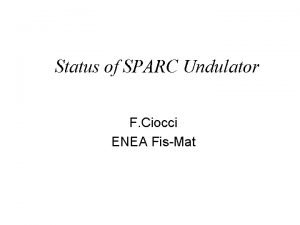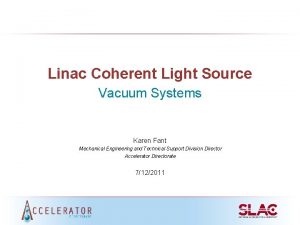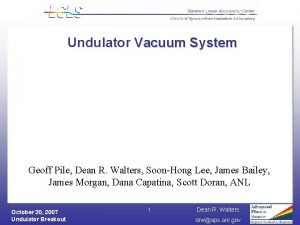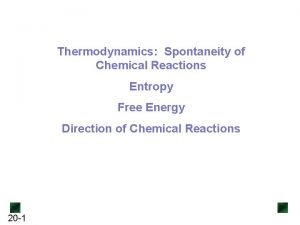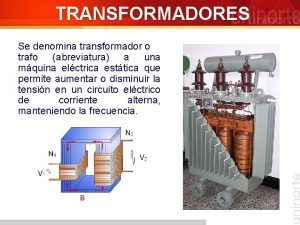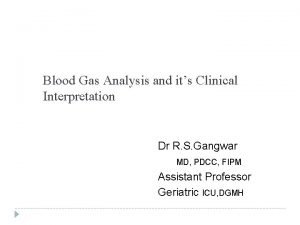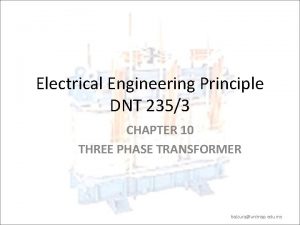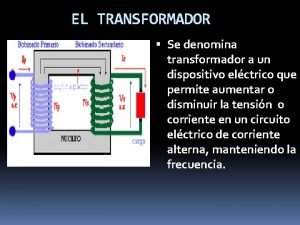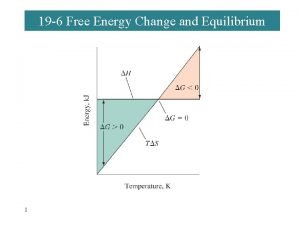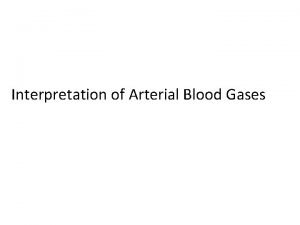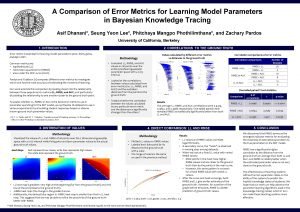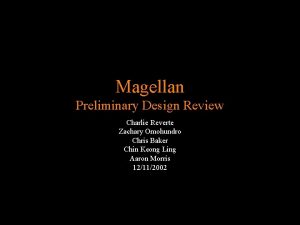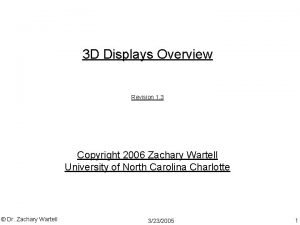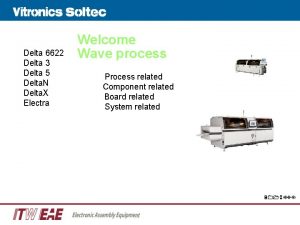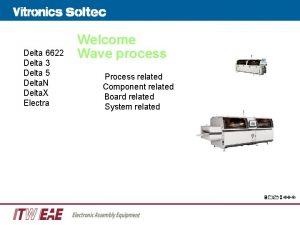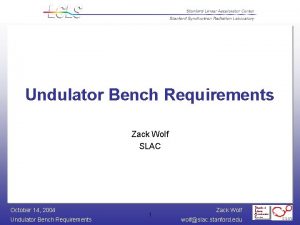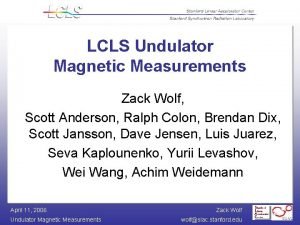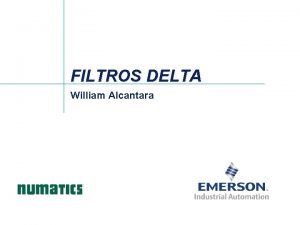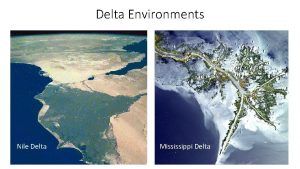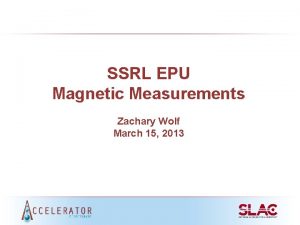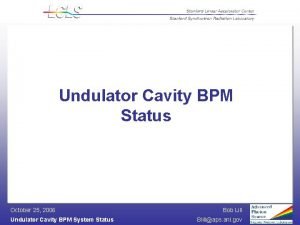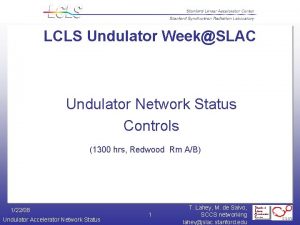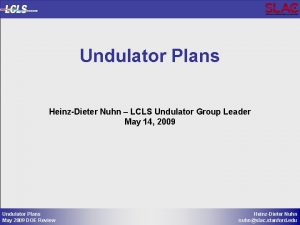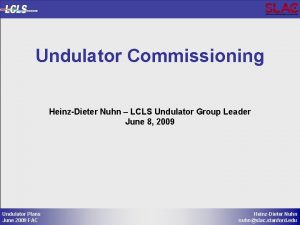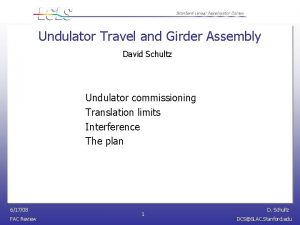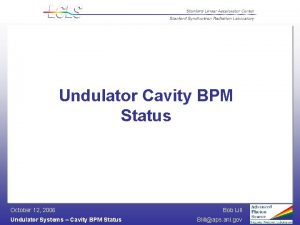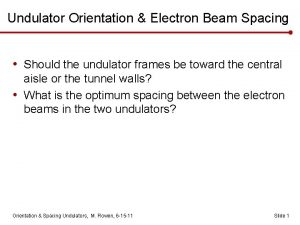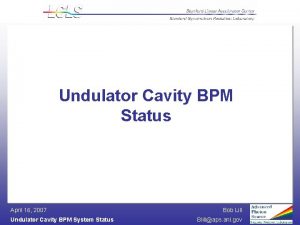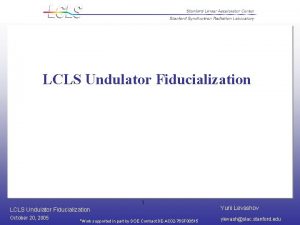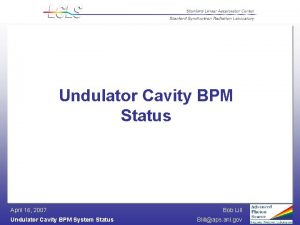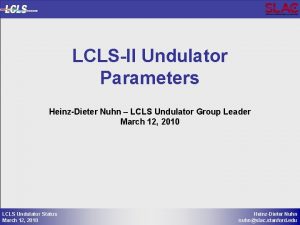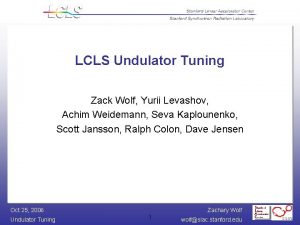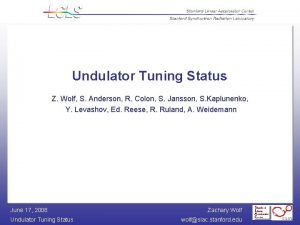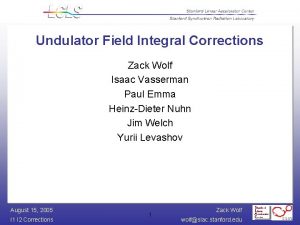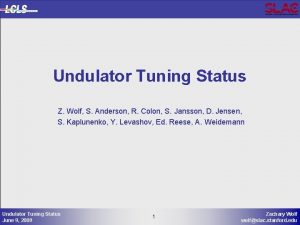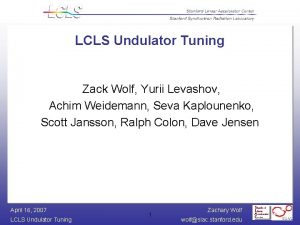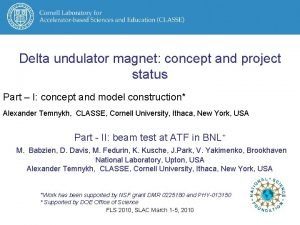Delta Undulator Measurements At SLAC Zachary Wolf SLAC






























- Slides: 30

Delta Undulator Measurements At SLAC Zachary Wolf SLAC IMMW 20 June 4 -9, 2017

Delta Undulator Produces elliptically polarized light. Placed at end of LCLS. Uses the microbunched beam. 2

Delta Undulator EPU in a package compatible with LCLS Use same alignment strategy. Undulator and quadrupole on the same girder.

Delta Cross Section Franz Peters 4

Delta Undulator Benefits: • Very compact source of elliptically polarized light Costs: • Can’t tune after assembly o Tune quadrants, use superposition • Very tight assembly tolerances • Measurements can only be done from the ends in a 6 mm diameter tube • Difficult to achieve the tolerances to required to make an FEL out of Delta undulators. 5

Delta Quadrant Assembly And Tuning Mechanically align blocks using CMM. Move blocks using magnetic measurements to straighten trajectories and minimize phase errors.

In Software Superpose Quadrant Fields To Simulate Assembled Undulator, Correct If Necessary Example CP+. Expect undulator within tolerance, but no permeability effects in superposition. (Prototype)

Delta Assembly 8

Delta Field Integrals Moving Wire Pulsed Wire

Hall Probe Measurements The only access for measurements is through the end of the beam pipe. 10

Measure Probe Position Transverse location from corner cube. Longitudinal location from interferometer. Georg Gassner

New Project LCLS-II, Delta-II Space for 2 -stage HXRSS Location for upgraded HXRSS Space for SXRSS Space for 3 Polarization Control Undulators 12

Delta-II • Challenges/Improvements - Position dependence of the K value - Assembly tolerance to minimize phase errors - Measurement/assembly plan on CMM - Measurements of assembled undulator 13

Delta-II K Value Position Dependence Swiss Light Source 14

Delta: Horizontal and Vertical Position Sensitivity LCLS MD 11/17/2015 Heinz-Dieter Nuhn LCLS MD 11/17/2015 *Alexander Temnikh, private communication

K Gradients In Delta • What causes the asymmetric position dependence of K? • There is only hyperbolic cosine position dependence in the model of two crossed adjustable phase planar undulators. • What are the alignment tolerance effects on Delta-II? • Is there a model to help explain this behavior so that we can make predictions for Delta-II? • Are there design changes that can minimize this effect? 16

A Model To Explain The Delta-II K Value Position Dependence Add field rolloff to the model of two crossed, planar, adjustable phase undulators. Model to explain the position dependence of K LCLS-TN-16 -1 For one quadrant Delta Measurements: ku = 196 1/m kr = 270 1/m ks = 186 1/m Potential decreases exponentially away from the quadrant, decreases away from the center line, varies sinusoidally in z, obeys Laplace’s equation. This potential can be considered the dominant term in a Fourier expansion. 17

Delta-II K Value Position Dependence Lab Frame Undulator Frame Potential for each quadrant: Do calculations in the undulator frame. 18

Delta-II K Value Position Dependence Combine quadrants 1 and 3, also 2 and 4. Two crossed adjustable phase undulators. 19

Example Position Dependence Of Fields Circular mode Krel = 0. 9 Bx changes 5% per mm. 20

Delta-II K Value Position Dependence Undulator frame. Linear mode LCLS-TN-16 -1 Approximate K near center Circular mode Full formula for K In the linear modes K vs x does not have a slope at the beam axis. In the circular modes, however, K vs x does have a slope at the beam axis. This can make setting several undulators to the same K value almost impossible using calibration and alignment techniques. 21

LCLS-TN-16 -1 Delta-II K Value Position Dependence Going to the laboratory frame and setting the relative shifts of the two variable phase undulators to be the same, the formula simplifies. There is a gradient in x, but not in y. Note that the gradient comes from the field rolloff ks. It grows as the row shift Δ increases. It is largest in the circular modes where δ = π/2. 22

With A Delta-like Undulator Predicted DELTA-II RMS X-Resonance Width Heinz-Dieter Nuhn No gap change. Change K by shifting rows. 23

Delta-II K Value Position Dependence The gradient depends on ks. It is zero for crossed planar undulators. The gradient gets bigger as the row shift gets bigger, or as the K value gets smaller. The gradient is zero in the linear modes, and is largest in the circular modes. The gradient will cause alignment problems with the three Delta-II undulators. Remedy: Franz Peters’ design Tried to shape magnets to minimize ks, but no success. Limited by block size. Operate at small relative row shift and increase the gap to adjust K. 24

Delta-II Construction Tolerances Delta Measured Peak Fields, LPVMF mode, Krel = 0. 9 LCLS-TN-15 -2 25

Delta-II Assembly Plan Build Delta-II On A CMM Move the blocks in order to move the magnet mechanical axis to the fiducialized geometric axis of the strongback. 26

Measure On Line Between Pointed Magnet Centers Line radial taper less than 8 microns. Line radial bow less than 18 microns. ‘Pointed magnets’ make the connection between CMM probe position and Hall probe position. We purchased software to move the CMM in a straight line and generate triggers uniformly spaced. Move blocks to tune quadrant. 27

Assembled Undulator Flats on E set Y and pitch. Use tooling balls on E to set X and yaw. Need tooling balls at ends to determine Y after assembly. (Green) 28

Measurements Of The Assembled Undulator Requirements: • Measure at many gaps • Measure at many row shifts • Measure in many modes • Measure the fields on-axis and off-axis Possible Solutions: • Safali --- We are trying to fit a Safali rail system into the mechanical design. • Probe Array --- An array of probes is very difficult to calibrate and it is hard to get all the cables out. Plus, corrections have to be made when the probe array goes off a straight line. Enough measurements need to be made to characterize the field and do the corrections. • Delta-I --- We can measure in a beam pipe centered on the beam axis, but this is not an ideal solution. • Safali --- We can possibly move a beam pipe to keep the probe moving on a straight line. 29

Conclusion • A Delta undulator was successfully built and used in LCLS-I • Modifications must be made for LCLS-II § The K gradient must be reduced (by moving the magnet arrays radially) § Tighter construction tolerances must be met § We are looking for a better way to measure the assembled undulator. 30
 Wolf hollow sanctuary
Wolf hollow sanctuary Konrad wolf judith catherine wolf
Konrad wolf judith catherine wolf Peter and the wolf grandpa
Peter and the wolf grandpa Undulator
Undulator Undulator
Undulator Undulator
Undulator Undulator
Undulator Entropy of reaction
Entropy of reaction Low anion gap causes
Low anion gap causes Abreviatura de transformador
Abreviatura de transformador Delta gap delta bicarb คือ
Delta gap delta bicarb คือ How to solve for anion gap
How to solve for anion gap Delta delta
Delta delta Partes del transformador
Partes del transformador Catmudpiles
Catmudpiles Delta ag delta hco3
Delta ag delta hco3 Delta ratio
Delta ratio Delta g = delta g not + rtlnq
Delta g = delta g not + rtlnq Delta g = delta g + rtlnq
Delta g = delta g + rtlnq Wye delta diagram
Wye delta diagram How to calculate anion gap
How to calculate anion gap Delta gap delta bicarb
Delta gap delta bicarb Gibbs free energy simple definition
Gibbs free energy simple definition Zachary pardos
Zachary pardos Berquist sherman method
Berquist sherman method Charlie reverte
Charlie reverte Harsch tenant portal
Harsch tenant portal Zachary ivey
Zachary ivey Zachary sprague
Zachary sprague Zachary wartell
Zachary wartell Zachary jacobson
Zachary jacobson



